Biting into resilient materials
Animal enamel provides a blueprint for advancing fracture-resistant materials.
By: Brooke Fisher
Photos: Dennis Wise/University of Washington
Top photo: A missing tooth from a lion skull was used for research by Professor Dwayne Arola’s lab, thanks to a partnership with the Burke Museum.
When it comes to developing next-generation engineering materials that are fracture resistant, a team of UW researchers is all smiles about the prospect of utilizing insight gleaned from the hardest tissue in all mammals: tooth enamel.
“I started researching teeth when I broke a tooth on a sandwich,” says Dwayne Arola, a professor of materials science and engineering (MSE) who has adjunct appointments in mechanical engineering, oral health sciences and restorative dentistry. “My dentist said teeth have a way to resist fracture. They are a mixture of mineral and hard tissue, so I got interested in why that occurred.”
The researchers are exploring exactly how enamel, which is the outer layer of a tooth, works to keep teeth functioning throughout a lifespan. Their goal is to ultimately inform the development of synthetic materials — for a variety of uses, such as structures — that are designed to manage cracks and not easily succumb to strong forces.
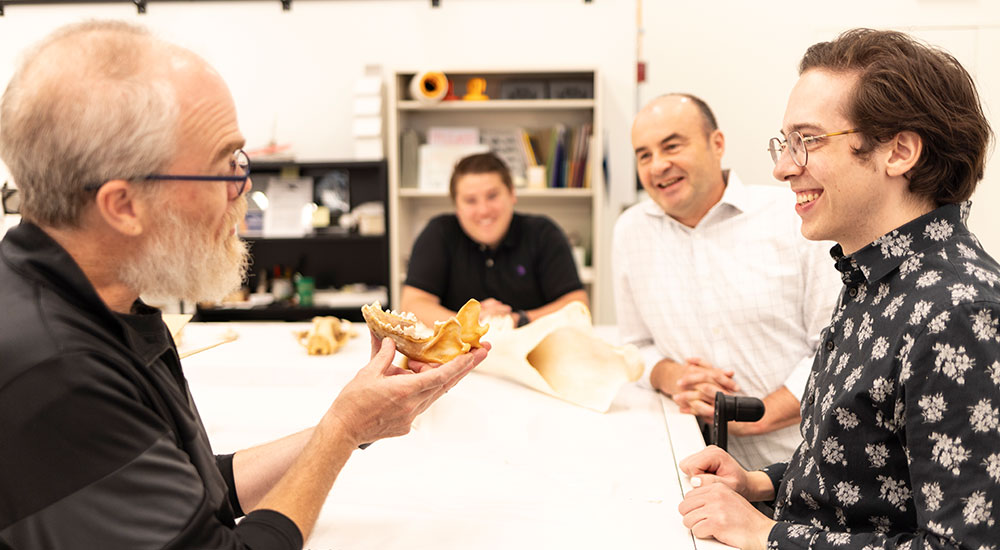
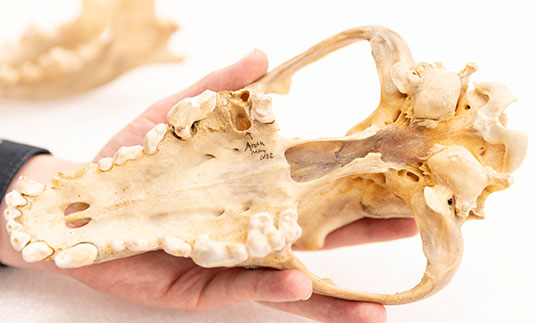
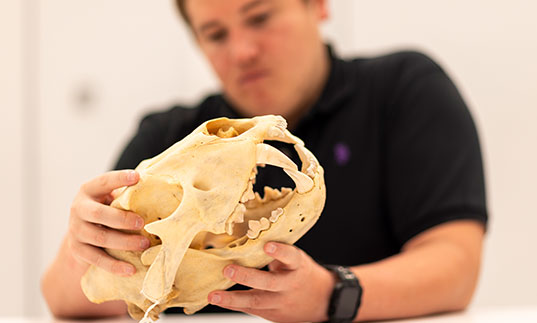
Left: Holding an African wild dog skull is Jeffrey Bradley, mammalogy collection manager at the Burke Museum. Top right: A wolf skull used by the team for sampling. Bottom right: Postdoctoral researcher Cameron Renteria with a lion skull.
The success of the project is largely due to investigating enamel from animals, rather than humans. Since animal enamel is less dense and not typically fluoridated except for zoo animals, the team discovered it is easier to view the underlying microstructure. To access animal teeth specimens, Arola, together with MSE Ph.D. student Jack Grimm and postdoctoral researcher Cameron Renteria, is collaborating with the Burke Museum of Natural History & Culture. Other partners include Ohio State University and Idaho National Labs.
“Teeth rely on enamel, which is arguably one of the most damage-tolerant materials in all of nature,” says Arola. “We are using reverse engineering to try and interpret what nature has done.”

Cracks become confused
Considering it is one of the strongest materials in the body of most mammals, with the exception of specialized tissues such as horns, enamel is especially unique. Composed primarily of the mineral hydroxyapatite, enamel has a natural tendency to be brittle. Cracking is therefore not only common, but expected.

A sectioned lion tooth sample is loaded on the stage of a scanning electron microscope.
“Why would Mother Nature put this material in this region when it’s subject to so many cycles of contact?” asks Arola, who points out that since enamel is acellular, it also can’t repair itself. “The most fascinating thing about enamel is that you can see cracks in the tissue, but they don’t often enable fracture of the tooth.”
To investigate what prevents cracks from propagating, the researchers began by monitoring cracks microscopically. They found that cracks grow inward and are eventually arrested before reaching dentin, the layer directly underneath the enamel. They attribute this to decussation, the pattern inherent in the microstructure of the enamel.
“The crack is confused and blocked by the woven pattern of the enamel rods,” Arola explains. “The woven patterns are important — they are the secret behind this. The crack is trying to follow the path of least resistance, but that keeps changing so it starts undergoing bifurcation or forking.”
Exploring enamel patterns
Since the microstructure of enamel varies among species, the researchers were eager to learn which animals possess the most fracture-resistant enamel. To do so, they correlated the decussation patterns to the functionality of the tooth — in this case, the strength of an animal’s bite, called the bite force quotient. This also takes into account the animal’s body mass.
“We think there are predation requirements — what the animals with high bite forces are eating, along with how they acquire food, requires a higher fracture toughness,” explains Renteria, who received his Ph.D. in 2023 from MSE. “We believe that’s what causes different patterns in the decussation.”
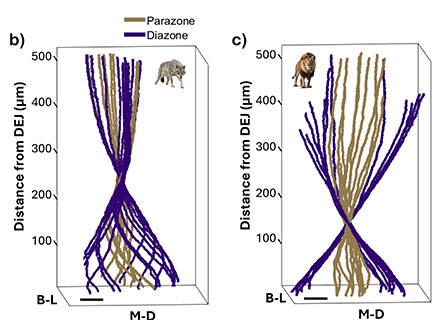
3D segmentations from X-ray microcomputed tomography allow the researchers to view the unique orientation and angles of enamel rods across species. Pictured are the structure of enamel rods in a wolf (left) and lion (right). The purple rods (diazone) travel diagonally while the gold rods (parazone) run lengthwise.
Since molars are subjected to higher bite forces, the researchers obtained molar specimens for various animals including lion, African wild dog, gray wolf, black bear and snow leopard. Using high-resolution 3D imaging technology called X-ray microcomputed tomography, they could clearly see — for the very first time across these species — unique patterns in the enamel microstructure, particularly the angles and orientation of enamel rods. Distinct designs in enamel from animals with the highest bite force quotient, namely lions, African wild dogs and wolves, also became more evident.
“The enamel rods cross each other at a steeper angle, which does a better job of constraining cracks — it takes the crack more energy to keep moving,” explains Grimm. “An African wild dog might be biting into bone, while other animals are eating softer foods, so its enamel is designed more for crack growth resistance.”

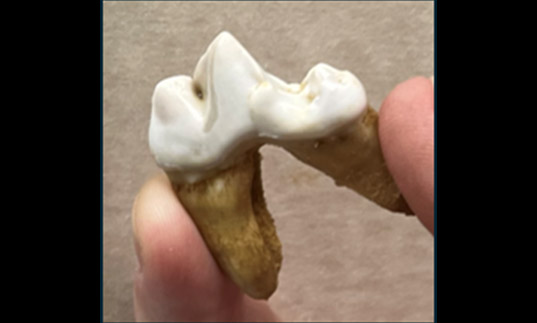
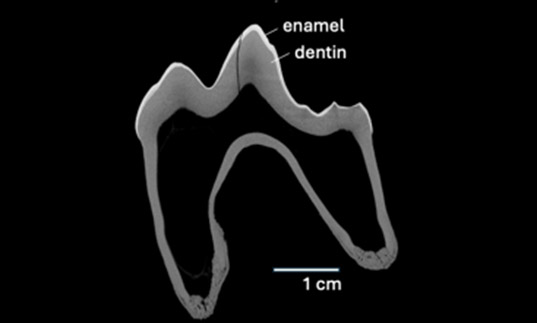
Left: Postdoctoral researcher Cameron Renteria and Professor Dwayne Arola, from left, peer into a scanning electron microscopy chamber that is loaded with a lion tooth sample. Top right: A gray wolf molar. Bottom right: The gray wolf molar scanned with X-ray microcomputed tomography, which enables the details of the enamel microstructure to be viewed.
Modeling Mother Nature’s materials
The researchers are currently working to define the exact composition of the patterns inherent in the enamel of animals with the highest bite force quotient. They also plan to explore enamel from different locations within the same tooth, to determine whether areas that have direct contact with food, such as the top of the tooth, have unique patterns.
The ultimate goal is to model the various microstructure patterns in synthetic materials to meet certain performance demands, from fracture toughness to wear resistance. The researchers envision assembling a library of design patterns that can be produced through additive manufacturing. Materials that don’t easily break when subject to strong forces could have a variety of uses, from armor for tanks to ballistics to structural materials for aerospace applications.

“Imagine seeing a crack on the outer surface of an airplane and being told it will stop, the materials will not allow it to penetrate any further,” Arola says. “We don’t have engineering materials like that yet — that would be the holy grail.”
The Burke Museum: A research partner and tooth ‘bank’
Located on the UW campus, the Burke Museum of Natural History & Culture cares for and shares natural and cultural collections with a focus on dinosaurs, fossils, Northwest Native art, plant and animal collections and cultural pieces from across the globe.
“The whole collection is here for research,” explains Jeffrey Bradley, mammalogy collection manager at the Burke. “Most people who use the collection are asking biological questions, so this [engineering collaboration] is unique.”
Except for rare items, the museum loans specimens to researchers nationwide. According to Arola, the museum “is like a bank for us.” He notes that the museum has storage cabinets full of teeth from a wide variety of mammals.